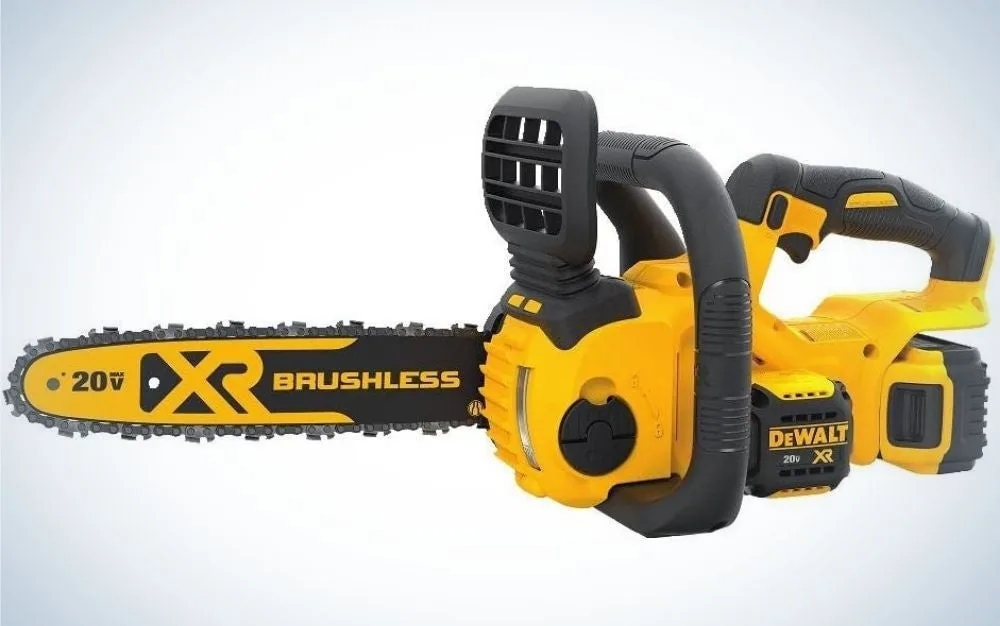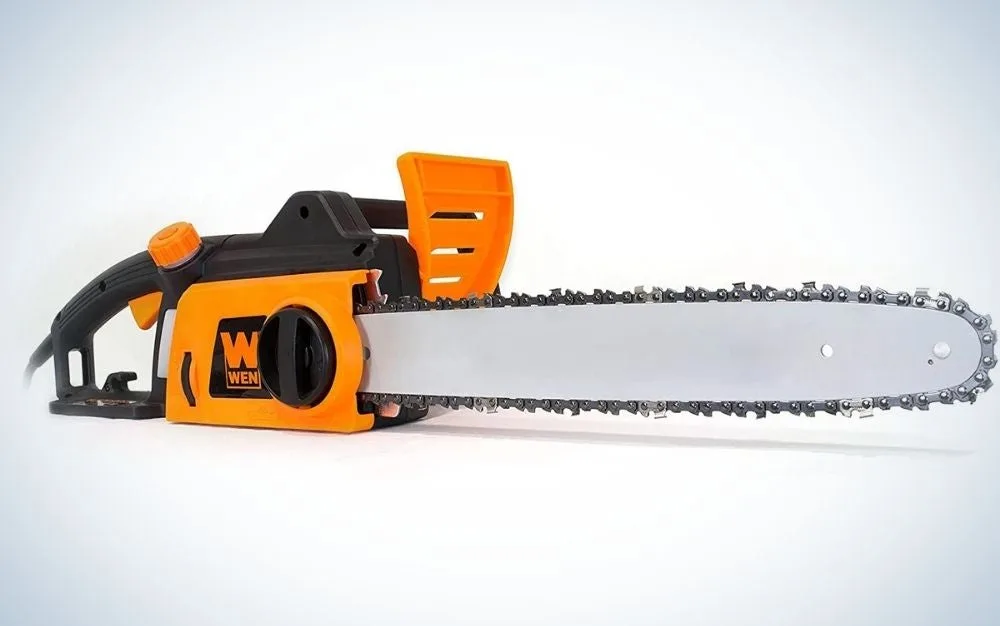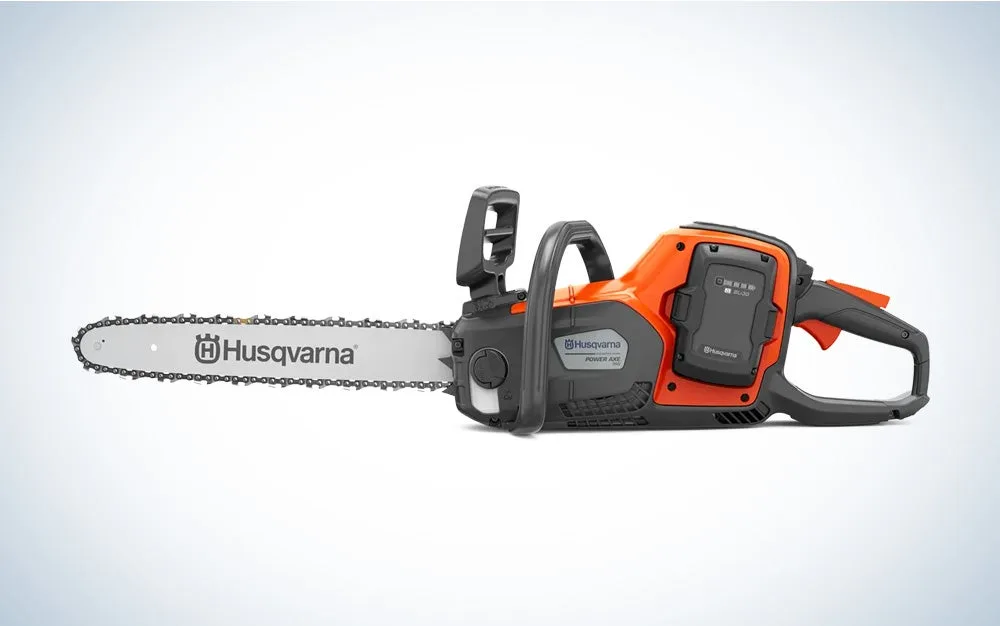_We may earn revenue from the products available on this page and participate in affiliate programs. Learn more ›
_
Best Cordless

DeWalt 20V MAX XR Chainsaw
LEARN MORE
Summary
The 12-inch bar is perfect for limbing and pruning, while the 9-pound weight makes it easy to wield all day, so you can cut enough brush for all your blinds without getting sore.
Best 18 Inch

Oregon CS1500 Electric Chainsaw
LEARN MORE
Summary
The 15-amp motor on the Oregon CS1500 delivers enough torque to keep it going during the toughest jobs. The aggressive tooth design makes short work of logs up to 16 inches in diameter.
Best with Extension Pole

DeWalt 20V MAX XR Pole Saw
LEARN MORE
Summary
The DeWalt 20V MAX XR Pole Saw extends your reach up to 15 feet so you can safely and easily work overhead. The 8-inch bar can handle limbs up to 6 inches in diameter.
Having an electric chainsaws is ideal for managing your hunting land, cutting firewood, and keeping the trees in your yard neat. In skilled hands, it becomes a powerful multi-tool
useful for a variety of scenarios. Because they don’t rely on internal combustion engines, electric chainsaws don’t create game-spooking fumes. The quieter the chainsaw is, the more it helps minimize disturbance, lessening the chance you’ll send that buck running to the next county.
Electric chainsaws offer instant start with the pull of a trigger, minimal maintenance, low noise compared to gas models, and are silent between cuts. Electric models are also lighter in weight than gas models, but offer similar capabilities. Just plug them in, or insert a battery, and get to work—no mixing oil and gas. Plus, electric chainsaws require very little maintenance—just an occasional sharpening of the chain and a quick topping off of the bar oil.
Gas-powered models have usually dominated in sales, but recent advances in battery technology have moved electric chainsaws toward the head of the pack. These new batteries offer plenty of runtime, so you can tackle a day of land management on a single charge. Pack a couple spares along and you can cut all day.
Best Cordless: DeWalt 20V MAX XR Chainsaw
Best 18 Inch: Oregon CS1500 Electric Chainsaw
Best with Extension Pole: DeWalt 20V MAX XR Pole Saw
Best Budget: Wen 4017 Electric Chainsaw
Best Lightweight: Husqvarna Power Axe 350i
How We Picked The Best Electric Chainsaws
I spent more than a bit of time working on habitat modification during my wildlife management career. To do so, I used a variety of gas- and electric-powered implements. I learned to identify some key characteristics that would make tools ideal, including:
Ease of Use: One of the biggest advantages of electric chainsaws is their ease of use. I chose models with features that made their operation even simpler, like automatic oiling systems, tool-free chain tensioners, and built-in sharpeners.
Durability: For a chainsaw to hold up to the rigors of land management, it must be tough. I chose models built with rugged materials that can handle the wear and tear that comes with log work.
Safety: Chainsaw use is dangerous. I chose models with safety features that minimized this risk.
Warranty: Even though I selected saws that should last, things happen. If your saw fails, you want to know the company will stand behind it. I chose chainsaws with good warranties, built by companies with solid reputations.
Value: Outdoor power equipment is an investment. The long life span of these chainsaws ensures they provide great value.
The Best Electric Chainsaws: Reviews & Recommendations
**Best Cordless: DeWalt 20V MAX XR Chainsaw
**
Best Cordless

Specs
Weight: 9 Pounds
Voltage: 20
Amp Hours: 5
Bar Length: 12 Inches
Cuts Per Charge: 90
Pros
Uses common, standard DEWALT 20V batteries
Tool-free chain tensioning
Lightweight at only 9 pounds with battery
Cons
Bar length limits the saw’s versatility
It’s not the most powerful battery out there, but the DeWalt 20V MAX XR Chainsaw uses the company’s excellent batteries—which odds are pretty good you already own a couple. This means that you can take the battery from your cordless drill and hit the Back 40 to clear brush, trim trees, and cut firewood. The compact size of the saw makes it the perfect companion for an ATV, clearing the trail to the duck hole or quickly building a blind.
The 12-inch bar is perfect for limbing and pruning, though this chain falls a bit short for most felling tasks. But if you need to clear shooting lanes or get a tree ready for a stand, the nimble length is ideal. The nine-pound weight makes it easy to wield all day, so you can cut enough brush for all your blinds without getting sore. An included scabbard protects your ride from the chain.
Usable life is excellent for a 20-volt battery pack, with the saw going through up to 90 pressure-treated 4 x 4s per charge. The high-efficiency brushless motor that maximizes runtime also increases motor life. Tool-free chain tensioning and an auto oiling system keeps maintenance to a minimum, so you can use your free time for more enjoyable purposes: like hunting. And if you already have a bunch of DEWALT tools, you can save some money by picking up the saw without a battery.
**Best 18 Inch: Oregon CS1500 Electric Chainsaw
**
Best 18 Inch

Specs
Weight: 12.6 Pounds
Voltage: 120
Amp Hours: 15
Bar Length: 18 Inches
Cuts Per Charge: N/A (Corded model)
Pros
Long bar and powerful motor can handle tough work
Chain brake for additional safety
Auto-sharpening feature reduces upkeep
Cons
Heavy for an electric saw at 12.6 pounds
Requires 15-amp electrical outlet for use
It takes a lot of power to keep an 18-inch chain and bar combo spinning through thick logs. The 15-amp motor on the Oregon CS1500 delivers enough torque to keep it going during the toughest jobs. The aggressive tooth design makes short work of logs up to 16 inches in diameter, so you can use this saw for felling duties. Even hard woods like oak are no match for the CS1500.
Not only is the CS1500 the best 18 inch electric chainsaw, it’s also powerful, and safe. Chain brakes are more or less standard equipment on gas saws, but not all electric models have them. If you’re not familiar, a chain brake stops the chain from rotating around the bar when it’s engaged. Pushing the handle on the CS1500 forward will stop the chain from spinning, as will the inertia created when the saw kicks back. This can prevent serious injury if the saw bucks.
Having a sharp chain not only makes cutting faster, but also increases safety. A sharp chain is less likely to kickback, making it easier to handle and eliminating a lot of potential for mishaps. The Oregon CS1500 is one of the first corded electric chainsaws on the market with a chain that can sharpen itself. With the PowerSharp Integrated Sharpening System, the chain can be sharpened in as quickly as five seconds by simply pulling on a lever. One of the perks of electric chainsaws is lack of maintenance, and this system takes that even further.
The CS1500 also offers one of the easiest-to-use chain tensioning systems on the market. Just turn the knob to take out any slack and get back to work in seconds. The auto-oiling system keeps friction, and operating temperatures, down by supplying a steady stream of oil that only requires you to fill the reservoir periodically. A low-kickback chain lessens the chance it will come back at you if the blade contacts a log at an awkward angle, further improving safety.
Oregon is recognized for making some of the best chains in the business. The CS1500 proves that they make one of the best electric chainsaws, too.
**Best with Extension Pole: DeWalt 20V MAX XR Pole Saw
**
Best with Extension Pole

Specs
Weight: 9.8 Pounds
Voltage: 20
Amp Hours: 12
Bar Length: 8 Inches
Cuts Per Charge: 96
Pros
Shaft extends from 10 to 15 feet
Bucking strip and tree hook make overhead work easy
Three-piece design stores easily
Uses standard DEWALT 20V batteries
Cons
Must be stored upright to prevent bar oil can leaks
Clearing shooting lanes, pruning trees, or keeping the area around utility lines free from interference doesn’t have to require a ladder. The DeWalt 20V MAX XR Pole Saw extends the reach of a regular handheld saw. But while allowing the user to keep both feet planted firmly and safely on the ground while they do it. The eight-inch bar can handle limbs up to six inches in diameter, so you tackle just about any lane-clearing chore with this saw.
The bucking strip/tree hook design makes it easy to contact overhead limbs and move the bar into position for cutting. The low-kickback design makes it easy to keep the saw in place. You can use the back of the hook to clear felled branches that become stuck on the way down. The powerful brushless motor and auto-oiling design mean almost nonexistent maintenance; just make sure to keep your chainsaw teeth sharp
whenever they get dull.
Though it’s not silent, the electric motor produces far fewer decibels than gas engines. This means you can lessen disturbance around your food plots and tree stands. And without the byproducts of combustion wafting in the breeze, you’ll also minimize scent that can spook game. So don’t worry if you don’t get all your trimming done well before the season starts. The three-piece design breaks down for storage to fit in the truck bed, UTV, and garage with ease. If you already have a bunch of DeWalt tools in your shop, you can pick up the saw without a battery and save a few bucks. And speaking of batteries, the DeWalt 20V MAX XR Pole Saw will provide up to 96 cuts per charge on 4 x 4-inch pressure-treated pine lumber. This means you’ll lose track of the two-inch diameter branches you cut before the battery dies.
Best Budget: WEN 4017 Electric Chainsaw
Best Budget

Specs
Weight: 10 Pounds
Voltage: 120
Amp Hours: 12
Bar Length: 16 Inches
Cuts Per Charge: N/A (Corded model)
Pros
Aggressive Oregon bar and chain provide rapid cuts
Tool-free chain adjustment and changes
Protective scabbard included
Cons
Requires 120-volt electrical source to run
may not be a name you’re familiar with, but it should be. They have been designing power tools in their home base of Elgin, Illinois, since 1951. In that time, they have played a role in developing several commonly used tools, including the electric jigsaw. Plenty of their tools have found their way into my home shop, where they have performed dependably for me over the years. And they have done so without breaking the bank.
WEN’s 4017 chainsaw features a 16-inch bar wearing an aggressive Oregon chain to make quick work of logs up to 14 inches in diameter. The 12-amp motor provides plenty of power, but doesn’t draw enough juice to throw the breaker in most home electrical systems. Despite all the torque this saw provides, it weighs in at only 10 pounds. It won’t fatigue users at the end of a long day.
The saw features a short power lead designed to be plugged into an extension cord. This makes it easy to swap cords in case of damage. A cord-wrangling hook inside the hand guard ensures it doesn’t pull out when cutting. If the bar does come into contact with the cord, the double-insulated design protects the user from shock. Just replace the extension cord and get back at it.
Chain changes are accomplished without tools, so you can easily remove them for sharpening or swap in a new one. You can quickly adjust chain tension as well, so you can take any slop out and get back to work in no time. An auto-oiling system keeps everything lubricated with minimal attention. For the price, this saw is the best electric chainsaw under $100.
Best Lightweight: Husqvarna Power Axe 350i
Best Lightweight

Specs
Weight: 7.72 Pounds (Battery excluded)
Voltage: 40
Amp Hours: 7.5
Bar Length: 18 Inches
Cuts Per Charge: N/A
Pros
Surprisingly light for the size
Very powerful
Interchangeable batteries
Cons
Long recharging time
This is one of the most powerful electric chainsaws out there for under $500. Husqvarna managed to keep the weight of this large saw’s body down to a trim 7.72 pounds without the battery installed. Considering the fact this saw has an 18-inch bar, that’s an incredibly manageable weight for a saw this size. This is a great option for older homeowners who have massive trees to maintain but can’t handle the weight and excess vibration of a heavy gas saw anymore.
This saw does have a longer recharging time, but the performance is quite comparable to a gas saw of the same size. Just without all the messy mixing of fuel and extra maintenance. For tougher jobs, a boost mode allows users to get a bit more power from the blade.
Another bonus is the fact the lithium-ion battery is completely interchangeable with Husqvarna’s other battery-operated tools. For anyone looking to ditch gas permanently, this is a good way to get started and get some extra value at the same time.
What to Consider When Choosing an Electric Chainsaw
There are more than a few things to keep in mind when you’re looking for an electric chainsaw. To get the right one for your needs, consider the following:
Corded or Cordless?
Where you will be using your chainsaw largely determines the power source you can utilize. A corded model is probably the better choice if you are on the grid or have access to a generator capable of putting out the amperage needed to power a saw. You won’t need to worry about running out of battery, and corded saws are typically more powerful. But if you are beyond the reach of the local power utility, battery-powered saws are the best options. Consider picking up some spare batteries, too, so you can work all day.
Power From the Grid
Corded saws are rated by amperage. This is the amount of power they draw before overheating or otherwise ceasing to function. The higher the amperage, the more powerful the saw is. The power needed varies depending on the task at hand. If you’re trimming branches no wider than a few inches, you can get away with an eight-amp saw. Limbing and some felling chores can be handled by a 12-amp saw, which is the power level found in most household outlets. The biggest jobs require 15-amp motors, which provide enough juice to run 18-inch bars.
Battery Power
While corded saws are rated using amperage, battery-powered saws are not. Their power rating is derived from the voltage of the battery used. The higher the voltage, the more power.
Typically, this ranges from 20 volts all the way up to 80. Twenty volts are plenty for most applications, but larger saws will require more power.
Batteries also have an amp-hour rating, also shown as Ah. This indicates how long the battery will provide energy for, not how powerful the motor is. Five amp-hour batteries can keep a saw running for quick tasks, but look for batteries with higher amp-hour ratings in the 6Ah or 8Ah range for all-day jobs. Or, pack a couple of extra batteries and never run out of power.
Bar Length
The bar is the protrusion that juts off the saw, on which the chain rides. The length of the bar determines how big a cut the saw is capable of. Typically, a saw can cut logs a couple inches shorter than the length of the bar. Bar lengths on electric chainsaws run the gambit from eight to 18 inches. Shorter lengths make for smaller, lighter saws. Larger bars are capable of bigger tasks, such as felling trees. Choose bar lengths around 12 or 14 inches for limbing and pruning chores; look for models with 16- or 18-inch bars for felling trees.
Chain Tension
Chainsaw chains should be kept at the proper tension. That means snug but pulling freely. But over time, chains are known to stretch, thanks to temperatures changes created by operating at high RPMs and centrifugal force. If a chain stretches enough, it can fit loosely or even pull off the bar, creating a potentially dangerous situation.
To combat this, chainsaw bars have a back-and-forward adjustment that takes the slack out of the chain. Many of these require a few hand tools to get the job done, but recently saws have been introduced that feature toolless tensioning systems. The easiest of these to use only require the user to loosen a knob on the side of the bar by hand, twist the adjustment knob until the slack is gone, and tighten the bar up again.
To determine if the chain tensioned properly, perform a “snap” test. Simply pull the chain on the underside of the guide bar down, so one or two links are out of the rails, and release it. The chain should snap right back into position.
Oiling Systems
In the old days, you had to pour oil over the bar to keep saws lubricated. Then came plunger systems that provided a shot of oil with the push of a thumb. Most saws now have convenient auto-oiling systems that keep the chain running in the bar’s groove without overheating. Make sure the saw you choose has one of these to keep the chain from wearing out prematurely and the saw running at optimal speeds for the fastest cutting. And top off the reservoir off before each use.
Safety Features
Chainsaws are inherently dangerous. Proper training and technique are required for safe usage. However some features can add a layer of protection. Low-kickback chains lessen the chance that the saw will come back at the user. Many electric saws come with a clutch that almost instantly disengages the chain when the trigger is released. This minimizes the potential for the chain to catch something it shouldn’t as the cut finishes. Some saws feature chain brakes mounted in front of the grip, engaging when the user pushes on the handle, or the saw kicks back.
FAQs
Q: Are electric chainsaws more dangerous?
All chainsaws are dangerous, but the additional torque in electric models present an additional concern. The fibers in chainsaw chaps are designed to entangle and stop the chain, but the high torque provided by the electric motor cannot be stopped in this manner.
Q: Are battery powered chainsaws worth it?
If you don’t want the hassle of mixing oil and gas, then yes. Many battery-powered saws are priced less than their gas counterparts, adding to their value. For occasional use, a battery-powered saw may just be the ticket.
Q: How long will a cordless chainsaw last?
How long a cordless chainsaw will last depends on the amp-hour (Ah) rating on the battery. The higher the number, the longer the battery should last. Expect about an hour of use out of small batteries.
Q: Can I cut down a tree with an electric chainsaw?
It is possible to cut down a tree with an electric chainsaw. However, this type of saw is a bit more limited in the size of trees that can be tackled. To tackle extremely large trees, a large, professional grade electric or a gas chainsaw will likely be required.
Q: What is a good size chainsaw for home use?
This depends largely on the type of property you own, and the trees on it. Most homeowners can get by with a 12 to 14-inch chainsaw. But if you have larger trees, or just a ton of wooded areas on a larger property, it’s not a bad idea to go with 18 to 20 inches. Just to ensure you have the proper tool for multiple cleanup situations.
Best Electric Chainsaws: Final Thoughts
Best Cordless: DeWalt 20V MAX XR Chainsaw
Best 18 Inch: Oregon CS1500 Electric Chainsaw
Best with Extension Pole: DeWalt 20V MAX XR Pole Saw
Best Budget: Wen 4017 Electric Chainsaw
Best Lightweight: Husqvarna Power Axe 350i
The best electric chainsaw for managing your land depends mostly on the power grid. For users who have access to electrical outlets throughout their land, then a corded saw is the best bet—these models provide unlimited runtime and plenty of power. If you can’t plug in, then a battery-operated model is the way to go.
Why Trust Us
For more than 125 years, Field & Stream has been providing readers with honest and authentic coverage of outdoor gear. Our writers and editors eat, sleep, and breathe the outdoors, and that passion comes through in our product reviews. You can count on F&S to keep you up to date on the best new gear. And when we write about a product—whether it’s a bass lure or a backpack—we cover the good and the bad, so you know exactly what to expect before you decide to make a purchase.






